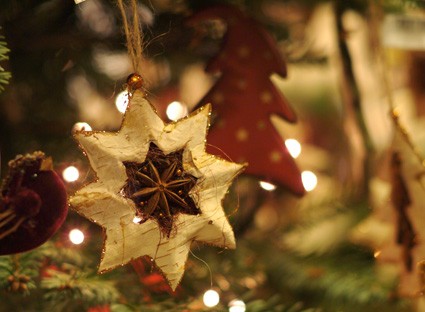Jeremy Musson on Christmas traditions
Jeremy Musson looks into the origins of some of our well-loved Christmas traditions


Christmas often brings out in us an unexpected pleasure in archaic and picturesque traditions, but where do they all come from? For instance, we've all heard the well-supported story that the decorated Christmas tree was principally introduced as an English fashion by Prince Albert, consort of the young Queen Victoria—the two were shown in a picture in the Illustrated London News in 1846, standing either side of a tree with their children. But where did Albert's own family custom come from?
Roots of the Christmas tree The 19th century was the great age of historicism, when Europeans harked back to a romanticised vision of life in the Middle Ages and traditions were revived. Bringing evergreens into the house can be identified as a Roman custom, and the ancient German pagan feast of Yule (held in November) included bringing living trees into the home—such pagan practices were adopted to Christian use in the 4th century.
The tradition as imported by Prince Albert could be traced back to the Paradise Play of the 11th and 12th centuries that featured a paradise tree, which linked the tree of knowledge in the Garden of Eden to the promise of the Saviour's coming. Mistletoe can also be identified in the midwinter Roman festival of Saturnalia—when kissing under the mistletoe was thought to boost fertility. Holly was similarly associated with Saturnalia.
St Francis: cribs and carols
One of the oldest Christian customs is that of the crib. This is traced back to St Francis of Assisi, who, in the 1220s, created a scene of statues within a small cave at the hermitage at Greccio to help people envision the nativity.
St Francis is also regarded as the founder of the Christmas carol sung as a shared chorus. The earliest-known carol in English is said to have been written by one Mr Ritson in the 15th century (the manuscript is in the British Library). Carols were famously banned under the Commonwealth, together with many Christian customs, although several returned with the monarchy in 1660.
Gobbling up turkeys
Sign up for the Country Life Newsletter
Exquisite houses, the beauty of Nature, and how to get the most from your life, straight to your inbox.
The British Christmas turkey came origin-ally from the Americas, but is confusingly so-named after those who traded in Middle Eastern goods, known as Turkey Merchants or Turkes. They traded in these fowls, which came to be raised in Asia, hence 'Turkey fowls'. Although the turkey was first brought to England in the 16th century, it was not considered a Christmas speciality until Edward VII made it popular—previously, the Christmas dish was more often the goose (even so, it did not become really widespread until the age of the refrigerator from the 1950s).
The proof of the pudding
The fruity pudding, which is such a central feature of the modern Christmas feast, can be traced back to the 14th century, when it was a more porridge-like form, called 'frumenty', based on beef, mutton, raisins, currents, prunes, wines and spices. In the 16th century, this was thickened with breadcrumbs, eggs, fruit and beers and spirits, and had become the traditional course to finish a Christmas meal. The pudding was also banned under the Commonwealth, although it had bounced back with a vengeance by the early 1700s.
Country Life is unlike any other magazine: the only glossy weekly on the newsstand and the only magazine that has been guest-edited by HRH The King not once, but twice. It is a celebration of modern rural life and all its diverse joys and pleasures — that was first published in Queen Victoria's Diamond Jubilee year. Our eclectic mixture of witty and informative content — from the most up-to-date property news and commentary and a coveted glimpse inside some of the UK's best houses and gardens, to gardening, the arts and interior design, written by experts in their field — still cannot be found in print or online, anywhere else.
-
 About time: The fastest and slowest moving housing markets revealed
About time: The fastest and slowest moving housing markets revealedNew research by Zoopla has shown where it's easy to sell and where it will take quite a while to find a buyer.
By Annabel Dixon
-
 Betty is the first dog to scale all of Scotland’s hundreds of mountains and hills
Betty is the first dog to scale all of Scotland’s hundreds of mountains and hillsFewer than 100 people have ever completed Betty's ‘full house’ of Scottish summits — and she was fuelled by more than 800 hard boiled eggs.
By Annunciata Elwes